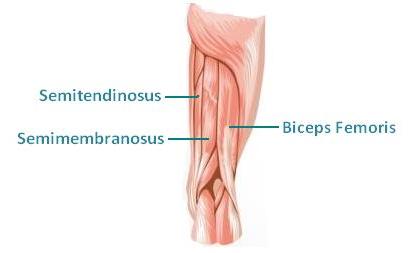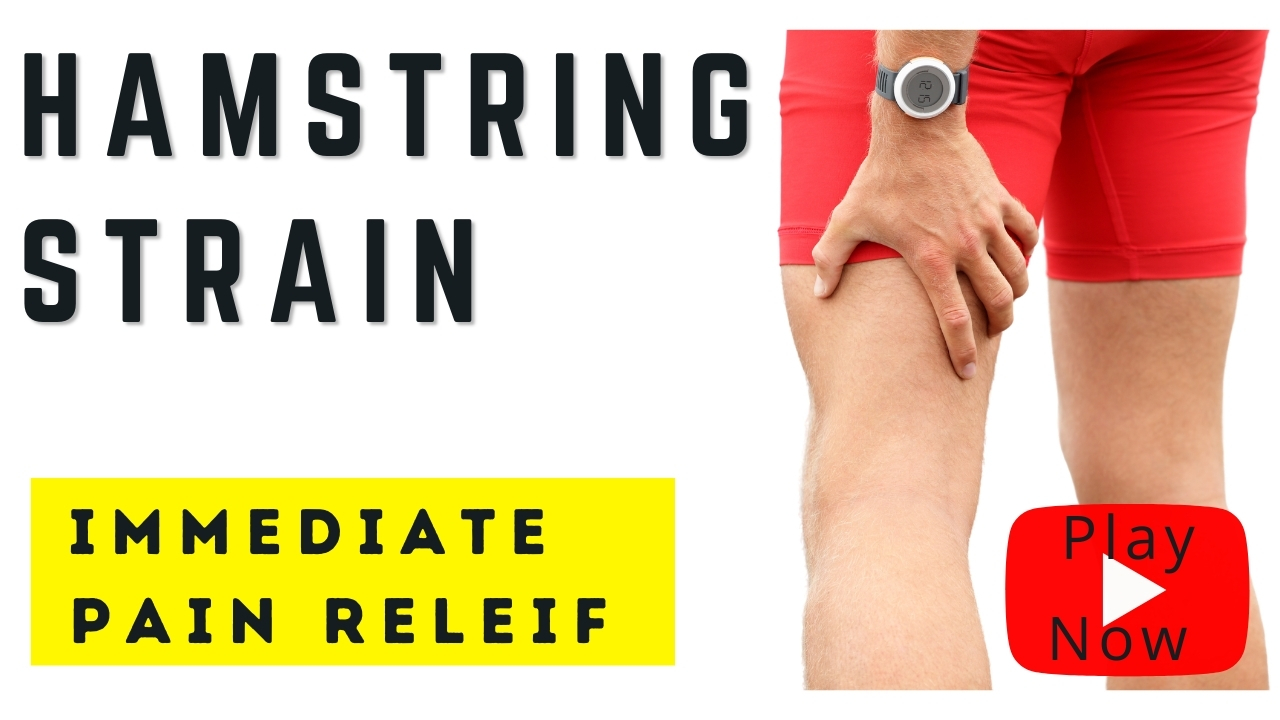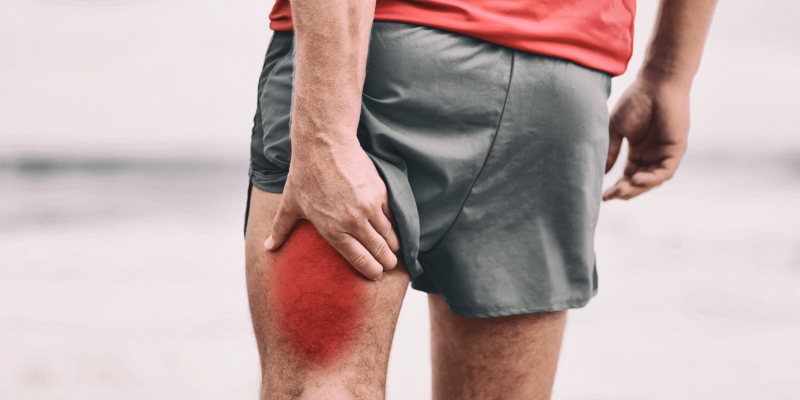Anatomy
There are three muscles in the back of the thigh that are collectively called the hamstrings. They are named biceps femoris, semitendinosus, and semimembranosis. The two attachment sites for the hamstrings are the ischial tuberosity (the bony prominence felt under each buttock when sitting), and the back of the knee at the tibia (shin bone). Contraction of the hamstring can cause the knee to flex, bringing the heel toward the buttock. The hamstrings also cause the hip to extend the thigh backward when the knee is straight. In addition, hamstring muscles provide control to the pelvis when bending forward with the knees straight. When walking or running, the hamstrings function to decelerate the leg and foot as it rapidly moves forward to land on the ground.

Hamstring Injury
A hamstring strain is an excessive stretch or tearing of muscle fibers and related tissues. Hamstring strains can occur at one of the attachment sites or at any point along the length of the muscle. They are classified as either1st, 2nd, or 3rd degree, with a grade 3 hamstring strain being the most severe.
A pulled hamstring muscle most commonly presents as a sudden pain in the back of the thigh during fast running or sprinting, when there are great force demands on the muscle. Although hamstring strains often occur while sprinting, they also can occur during jumping and other activities where quick starts and stops are required. High-risk sports for hamstring strains are soccer, football, rugby, baseball, basketball, water skiing, and many track and field events. Runners are especially susceptible to chronic hamstring strains due to the repetitive nature of the sport. Also, when there is an imbalance of the strength of the hamstring muscles with relation to the quadriceps muscles, the risk of hamstring strain is greater.
The severity of Muscle Strains:
Muscle strains are graded as mild (First degree), moderate (Second Degree) and severe (Third-degree). The more severe the strain, the longer the time to recover.
First Degree (Mild). This injury is the most common and usually the most minor. This injury is a ‘pulled muscle’ with a structural disruption of less than 5 percent. With a first-degree injury, you can expect to be back to sports within 1 to 3 weeks.
Second Degree (Moderate). This injury consists of a more significant, but still incomplete muscle tear. This a partial muscle tear and require 3 to 6 weeks of rest and recovery before you can return to full activity.
Third Degree (Severe). This injury results in complete tearing of the muscle-tendon unit. A third-degree muscle strain can take many weeks or months to fully heal.

Hamstring Injury Treatment
We would suggest visiting a physical therapist for a comprehensive assessment and diagnosis. Initially, manual therapy and soft tissue work around the injured area will improve movement and circulation. However, we prescribe a rehab program from the initial session.
Active rest help quicker recovery. Immediately following the muscle strain, you should follow POLICE protocol which is including, Protection, Optimal Loading, Rest, Ice, Compression, and Elevation. This procedure should be applied within the first 24 to 72 hours immediately after an injury.Ice should be applied over the painful area for 20 min. Periodic icing (2-3 times per day) will help to reduce pain. Heat should not be applied to the area during the first 7-10 days since this may increase swelling and bleeding within the muscle.
An elastic wrap or compressive stocking may be applied to the area to assist with swelling control. If the compressive device causes increased discomfort or “pins and needles” in any part of your leg, it is probably too tight.
Lying down periodically with your leg elevated allows gravity to assist with your effort to control the swelling. However, the expert does not suggest a complete rest.
As a general rule of thumb, any activity that elicits pain at or near the injured site may be causing further injury and will only hamper your recovery effort.
A gradual conditioning program, specific to your sport, will prepare the hamstrings for the high demands placed upon them during athletics. Don’t forget to incorporate a proper warm-up session into your conditioning program and athletic competition.
Hamstring Injury Rehabilitation Program
We would suggest visiting a physical therapist for a comprehensive assessment and diagnosis and exercise prescription. The ‘timeline’ that is illustrated in the following rehabilitation program is typical after grade 2 and 3 injuries. After a grade 1 injury, rehabilitation can usually begin at phase three.
Phase one – The first 2 weeks after injury
• Hamstring Active ROM Activation (3 sets of 5 to 8 repetitions).
• Hamstring curls Prone, body weight (3 sets of 8 to 10 repetitions).
• Glute Bridges body weight (3 sets of 8 to 10 repetitions).
• Avoid painful activities such as run, hiking, direct compression, massage.
• Ice 20 minutes, three times a day (no direct contact with skin).
• Active range of movement (within pain-free range) 5 to 10 repetitions.
Phase two – the second and third week after injury
• Ice once a day, 20 minutes, after exercises.
• Active range of movement, 3 times a day, 10 to 15 repetitions.• Hamstring Isometric Activation (3 sets of 5 to 10-sec hold).
• Heel slides (towel assist if painful).
• Calf raises 3 sets of 8 to 10 repetitions.
• Standing hamstring curls.
• Prone straight leg raises 3 sets of 8 to 10 repetitions.
• Stationary bicycle, 10 minutes, no resistance.• In this phase of rehabilitation avoid stretching.
Phase three – the 4th, 5th and 6th week after injury
Begin gentle strengthening, 1 time a day, 5 days a week, 15 to 30-sec hold
• Standing hamstring curls, add ankle weight one pound a week to 5 pounds.
• Standing or prone straight leg raises, add ankle weight one pound a week to 5 pounds.
• Stationary cycle, add resistance 1 minute per session up to 30 to 40 minutes.
• Slow treadmill walking, pain-free, start 5 minutes and add one minute per session to 20 minutes.
Strength Training Program
Strengthening program is designed to help you to rebuild the strength around the hip and the knee muscles after the injury to the hamstring muscles. A strengthening program is essential and will be customized to an individual depends on the level of activity. Precautions• Avoid pain at the hamstring strain site (we will coach you closely).
• Build up resistance and repetitions gradually (you will get your own customized sets and repetitions).
• Perform exercises slowly avoiding quick direction change and impact loading (avoid too much too fast).• Exercise frequency should be 2 to 3 times a week for building strength.• Be consistent and regular with the exercise and follow the Progressive Resistance Exercise protocol.  Progressive Resistance Exercise (PRE) Principle
Progressive Resistance Exercise (PRE) Principle
– To build muscle strength and size, the amount of resistance used must be gradually increased.
– The exercises should be specific to the target muscles.
– The amount of resistance should be measurable and gradually increased over a longer period of time.
– To avoid excess overload and injury, the weight must be gradually increased in increments of 5 to 10 %.
– Resistance can be increased gradually every 10 to 14 days when following a regular and consistent program.
– Adequate rest and muscle recovery between workout are necessary to maximize the benefit of the exercise.
– At a certain point, the joints and muscles will become overloaded and injury will occur.
– This eventuality can be avoided by refraining from using excessive weight during strength training.
Our Approach
Dublin Sports Injury Clinics a Physical Therapy Clinic based in Fitzwilliam Square, Dublin2. We have a thorough assessment to role out the mechanism of your injury. The primary objective of our rehabilitation program will be the restoration of function to the greatest possible degree in the shortest possible time. We believe the Patient’s education is an essential part of the rehabilitation program. We will explore the main root of their injury in layman terms and also show them the reason behind their rehabilitation program. Treatment will be classified into different phases according to the length of time since the injury occurred. We design a customized rehabilitation program for every individual to help them to recover as quickly as possible. We coach our patients and show them correct techniques and we progress their program step by step to help them get back to do what they love even stronger.
Next step
Want to get in touch with our team of the therapist or you are looking for some advice? Simply fill in your details below & we get in touch with you shortly.
Disclaimer: This article is for information only and should not be used for the diagnosis or treatment of medical conditions. You can contact us if you would like to book an appointment or get some advice from our therapist.
